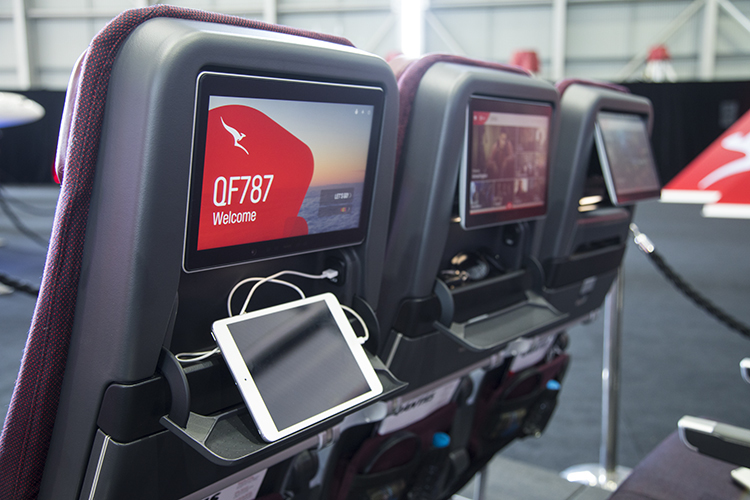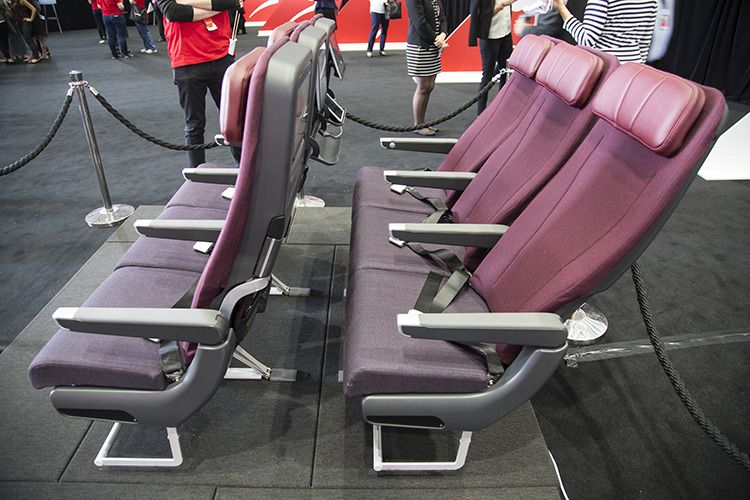
While Qantas’s first destination with the Boeing 787-9 has been kept under wraps for now, the aircraft’s seat configuration is the strongest indication yet the Dreamliner will be deployed on some of the world’s longest routes.
In front of invited guests, media and airline staff at Qantas’s Mascot base on Thursday morning, chief executive Alan Joyce unveiled the seat layout that, at first glance, features a heavy emphasis on premium seating while attempting to give something back to those flying in the main cabin.
When Qantas’s first 787-9s begin to arrive from October 2017 they will feature 42 business class seats (in a 1-2-1 configuration), 28 premium economy seats (at 2-3-2 abreast ) and 166 economy seats (at nine abreast) for a total of 236.
The 70 business and premium economy seats represent 30 per cent of the cabin, which is the highest percentage of premium seats on board any of Qantas’s widebody fleet.
By comparison, the four-class Airbus A380 has 23 per cent of its 484 seats in first, business and premium economy, while the A330-300s that are used mainly to Asia have nine per cent of the 297 seats in business and the rest in economy.
The table below has the full breakdown of Qantas’s widebody fleet.
Boeing lists its 787-9 with a range of 7,635nm when carrying 290 passengers in a two-class configuration.
The Qantas fit out suggests it will be looking to maximise the range performance of the aircraft for use on any number of often mooted ultra long-haul routes.
As a reminder, Perth-London Heathrow is 7,829nm and Melbourne-Dallas/Fort Worth is 7,814nm. Meanwhile, Sydney-Chicago is 8,022nm. The first route was expected to be announced “in the coming months”, Qantas said.
“We’re planning to make the most of the 787’s amazing range, so we’ve designed the cabin to give Qantas passengers a better experience on long-haul flights,” Joyce said in a statement.
Currently, the longest route operated by a 787-9 is United’s 7,339nm San Francisco-Singapore nonstop service, which kicked off June. United configures its 787-9s with 48 business, 88 extra legroom economy and 116 standard economy seats for a total of 252 seats. Singapore Airlines (SIA) uses Airbus A350-900 equipment on the same route.
Business and economy seats get a makeover

Qantas described the business class seat chosen for the 787-9 as an “evolution” of what is currently on board all A330-300s and all but two A330-200s that fly to Asia, Honolulu and on domestic trans-continental routes.
The Thompson Aero Seating product features direct aisle access for every passenger and can be partially reclined during takeoff, and landing has been given a refresh in collaboration with Australian industrial designer David Caon, Qantas said.
In economy, Qantas has adopted the industry standard for the 787 of nine seats per row in a 3-3-3 layout.
While that means a seat width of less than 18 inches, Qantas pitched its 787-9 economy seat at 32 inches, one more inch of precious legroom than on board its A380s.
The seats themselves have been designed by Recaro – the same manufacturer that supplies the new economy seat on board Qantas’s refurbished A330s – and feature extra storage spaces, a tablet holder, USB and power ports, a footnet, an extra light and the latest high-definition seat-back entertainment screen.
“Many of the cabin design elements reflect what our customers have told us. Personal storage rates really highly, so we’ve created extra space in economy for customers to store their personal devices and water bottles,” Joyce said.
“We’re also redesigning the in-flight experience for the Dreamliner, from rethinking our menus to making better use of the self-service bars during different phases of flight.”
Qantas has also promised a “revolutionary” premium economy seat, with details to be unveiled “in early 2017”.
Japan Airlines is currently the only operator of the 787 with eight across in economy. ANA had eight abreast in economy for a while, but has now switched to nine abreast across its fleet of 787-8s and 787-9s.

Cabin density at the lower end compared with other 787 operators
The two Japanese carriers operate three-class 787-9s with some of the fewest seats out there – Japan Airlines’ 787-9s have 195 seats (44 business, 35 premium economy and 116 economy), while local rival ANA has 215 seats (48 business, 21 premium economy and 146 economy) on its 787-9s used on international routes.
Qantas has one more seat than Etihad Airways, which has 235 seats on its three-class 787-9 comprising eight in first, 28 in business and 199 in economy.
Across the Tasman, Air New Zealand has 302 seats on its 787-9s, with 18 in business, 21 in premium economy and 263 in economy. However, the Kiwi carrier has announced plans to take three of the type with a more premium layout featuring 275 seats (27 business, 33 premium economy and 215 economy).
Will Qantas move to a consistent product across widebody fleet?
The arrival of a refreshed business class seat essentially maintains a product split between the A380/refurbished 747s (Sky Bed MK II) and the refurbished A330/787-9 (Thompson Aero Seating).
And given the increasing focus on direct aisle access for those travelling in business class, it will be interesting to note if, perhaps when, Qantas will move to upgrade its premium cabins on the four-engined A380/747 to match what is on offer on the Boeing and Airbus twin jets.
The one complication may be that because the 747s have only a limited lifespan at Qantas – the company has said on several occasions the 787-9s have been bought to gradually take over routes operated by the type – it may not be until the last jumbo is retired that the airline will have a consistent premium offering on all of its widebodies.
Qantas aircraft |
First |
Business |
Premium |
Economy |
Total |
Percentage premium |
|
Airbus A380 |
14 |
64 |
35 |
371 |
484 |
23% |
|
Airbus A330-300 |
0 |
28 |
0 |
269 |
297 |
9% |
|
Airbus A330-200 |
0 |
28 |
0 |
243 |
271 |
10% |
|
Boeing 747-400ER |
0 |
58 |
36 |
270 |
364 |
25% |
|
Boeing 787-9 |
0 |
42 |
28 |
166 |
236 |
30% |
Source: Qantas
















Craigy
says:I like the new tablet holder and USB port in economy. It is a nice addition.
Aruna
says:I think the new design. When Qantas said it was going to be a revolutionary business class to me I was expecting something complete different from the A330. I still like the design though
Cameron
says:I really think Qantas has made a big mistake not getting the 747-8i. It’s the best aircraft out there for Qantas with our need for four engines on many routes. Plus it just looks fantastic 🙂
Stephen Boyce
says:Since the boeing 787-9 can fly the distance. For twin engined aircraft like boeing 787-9 with E330 Etops and airbus a350-900 &1000 with E370 Etops. Can Qantas Fly Sydney Johannes burg S. Africa and Sydney Santiago Chile with twin engined aircraft? Airbus a350-900 and boeing 787-9 should be able to fly these routes no problem
David
says:Honestly Qantas seats put Gulf airlines on defense. Emirates is good but that’s yesterday’s news.
J_sh
says:Why is it that most journalists are just rehashing Qantas misleading propaganda regarding increased space on the 787 designed for long distance flights when the majority of passengers will be in economy where the seats have been reduced in width compared with a decade or two ago yet passengers have increased in width. The 787 was based around a point to point model rather than hub and spoke. P2P may work with reduced space for economy over short flights but Qantas is sending economy passengers to other aircraft and other airlines. Referring to this aircraft as Dreamliner is now an sick joke. Well its not quite as bad as Air Canada now fitting 10 across Sardine Class I guess but there are plenty of other choices out there.
Tropicalcat
says:I assume Alan Joyce must be the prototype passenger for the new shrunken width economy seats.
Oh, you didn’t pick that up in all the PR fluff. 9 yes that’s 9 across. What are other 78’s in economy, 8. Is this variant any wider?? No….
End result less room, now bet you didn’t pick that in all the QF rubbish.
Charles Falkiner
says:Having flown the 787 LAX-MEL-LAX in economy, it is just another boeing widebody – the only good point is the higher cabin pressure which does help with jet lag east west but not so much west east. Also the deafening scream of the flap motors is very annoying and needs to be addressed. The 380 is way ahead in comfort and quietness.
Richard Miller
says:Having recently endured a 9-hour Jetstar flight Syd to Hawaii in the 3 x 3 Cram/Dreamliner economy, at about 18 in width (no, I didn’t have a measure), complete with narrow hard-edgy dividers euphemistically called armrests, my next flight will be with any competitor which carries people, not templates, Qantas is very close to offering seats which are patently unfit for purpose for a large percentage of the ordinary population. Consumer Affairs, please note.